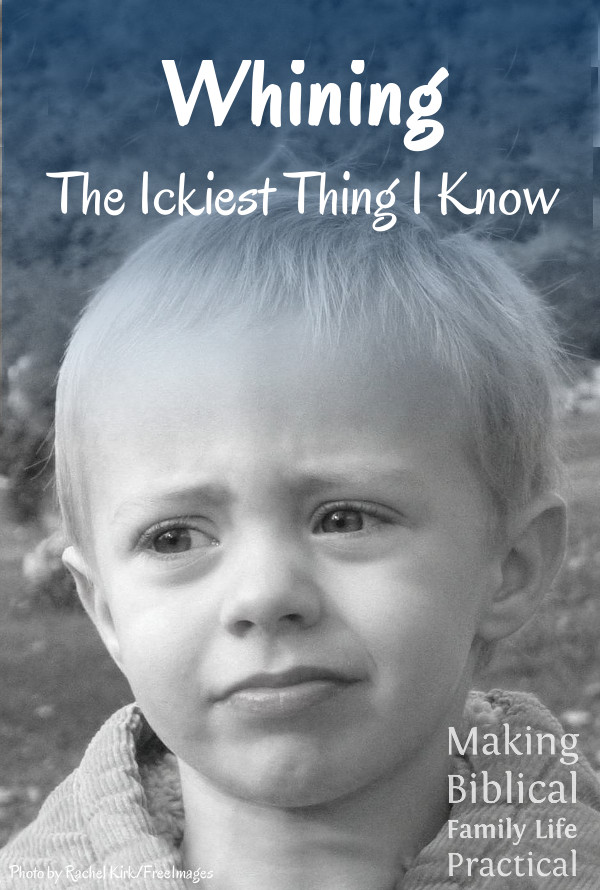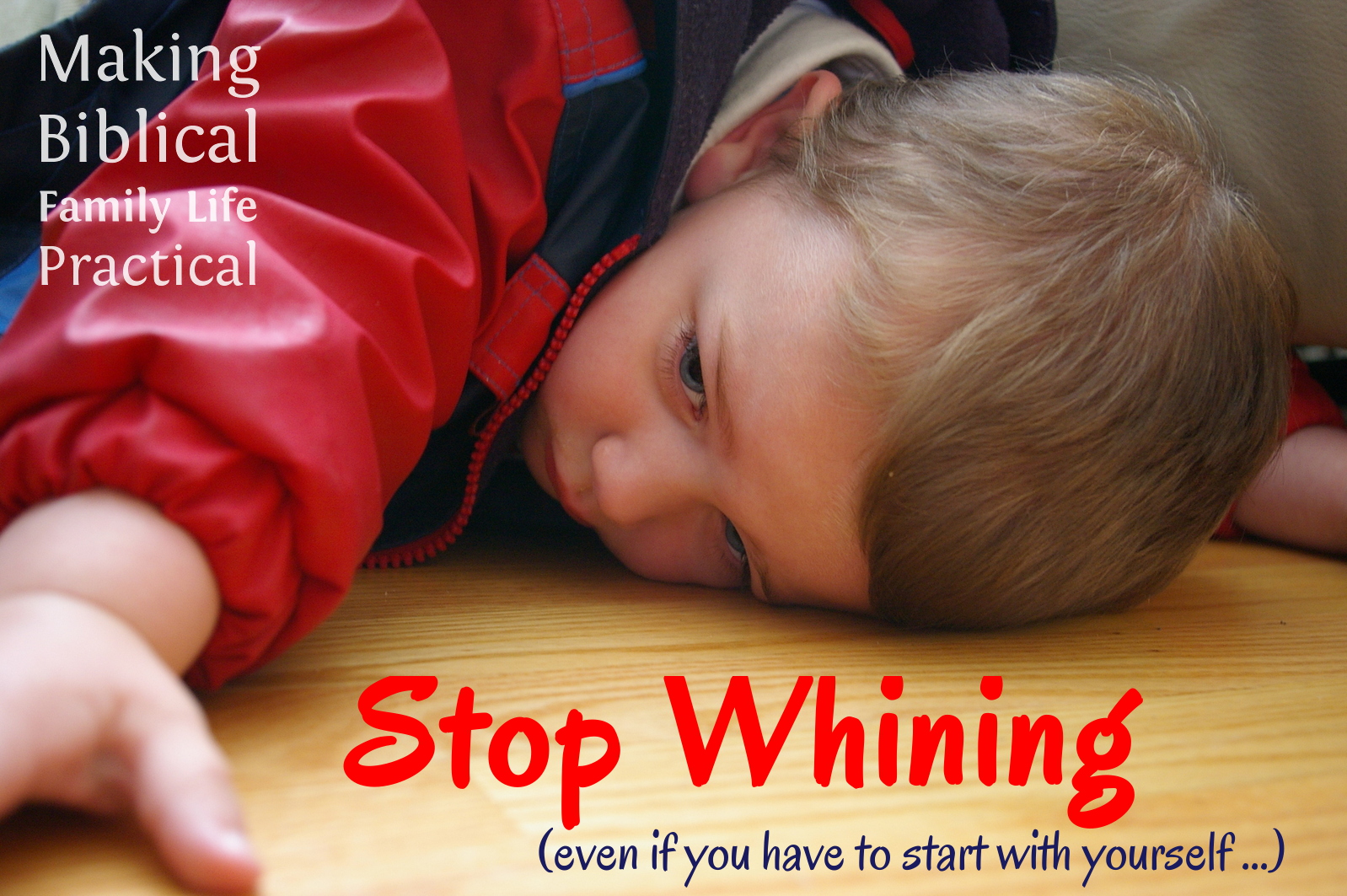Simple, Practical Ways to Get Rid of Whining
We all love our kids but there’s something that nearly every parent struggles with, something nearly every child does sometimes, and something which some kids do all the time.
WHINING. Oh, that awful sound.

It’s no surprise when a baby cries, and it shouldn’t surprise us that a young child whines. A baby has to communicate its needs somehow, and if we’re paying attention—and willing to respond when the first warning signs appear—many babies can be nurtured and comforted quickly, without a stressful contest of who can cry the longest. We really don’t think a 6-month-old is being manipulative or malicious when they cry for nourishment, comfort, or even attention; they have needs and not much way to ask politely … or to exercise patience and self-denial.
Toddlers, well, that’s a different story. Little kids have very short attention spans—except for the ability to whine. That can go on forever.
Two observations that helped us
First, attention given early is often shortest. When the 3-year-old runs up to a distracted parent, how often we try to put him off. “Just a minute … not now … Mama’s busy …” Sometimes there’s no option. Often, though, if he doesn’t get a response from Mama, the whining starts … which grates on our nerves, and makes us even less patient (and less able to concentrate on what we were doing).
What if, instead, we try to pause what we might be doing—teaching spelling, answering an email, whatever—if we put our activity on hold for a moment and give the little one our full attention for just a minute? Eye contact, a hug, real engagement … Very often, thirty seconds of real connection will meet the little one’s need, and he’ll run off happily.
Or else, we can put him off as long as it takes … and try to be productive in spite of the increasing whine. Not really efficient … and not really that loving, usually.
But whining is a behavior, and that means you can train it! It’s a form of communication, and just like we teach children to say “Yes, ma’am” or “Please” and “Thank you”, we can teach our kids not to whine.
Invest the time to stop the whine
Do they even know what they’re doing? Small children aren’t very self-aware, other than, “I want” and “I feel.” If whining gets on our nerves (if?), then we need to teach them better ways to express their needs. Invest the time to stop the whine. Stop what you’re doing, if you can, and explain how to ask more politely.
“Sweetie, the way you’re speaking is very unhappy to listen to. ‘Maaaaaamaaaaa … I’m hunnnngry.’ That’s called ‘whining,’ and it makes people unhappy with you. Let’s try it this way–‘Mama, I’m hungry. Can I have a snack?’ Can you say it that way?”
And then reward improved behavior! (This is all about the tone, not the grammar … you can work on “Can I” vs. “May I” another time.)
After you’ve made this point, so the young one realizes that whinnnninnnng is something they need to avoid, then you can offer some negative reinforcement. This is normally just irritation and socialization, not a matter of sin and rebellion, so we use very mild corrections:

- Time out for whining. This is probably the only time we recommend “time out” as an effective discipline! We told the whiner, “I’m sorry, that’s what I warned you about. You’ll have to be silent for one minute. You’re not allowed to talk until the timer goes off.” Whether you use a kitchen timer (tic tic tic tic tic tic tic tic …) or the countdown on your cellphone, make a big deal about starting and ending the quiet time. Add minutes if they start again. “Whoops, there’s that tone again. You can’t talk for two minutes this time …” We had one pessimistic child who worked up to twenty minutes before he changed his tone! But a two- or three minute pause can be very effective with a young, impatient child. If nothing else, you get a short break of listening to it!
- Older kids need reminders, too. When a teenager gets whiney—and they do, sometimes—you can laugh it off. “I’m sorry, when I hear that tone of voice, my brain just shuts down. I don’t speak Whine. Can you re-phrase that in a normal tone?” (A co-worker asked a complainer in his office, “Would you like some cheese to go with that whine?”)
- Don’t reward bad behavior. Sometimes it’s effective to make an “automatic no” rule—you whine, you don’t receive. Never give the impression that a big-enough bother will get the child what he wants. But use some mercy! If a child comes up to whine, “Maaaamaaa, I need a Baaaand-Aid …” he may actually need some first aid right then. And if a kid is grumpy and complaining at the end of a 300-mile car trip, who can blame him?
As a father pities his children, so the LORD pities those who fear Him. For He knows our frame, that we are but dust.
(Psalm 103:13-14)
- Remember this is a long-term, low-intensity problem. You don’t have to slay every dragon every time. You’ll have plenty of opportunities to teach effective communication skills. Sometimes you hear the whine and it just makes sense to let it pass—you really can’t pause what you’re doing, or the child is sick or exhausted and can’t help themselves, or it’s just not a good time to engage this parenting issue. It’s okay to deal with it another day.
 |
When you’re training them not to whine, though, don’t overlook the underlying problem …(to be continued …)
In Christ |